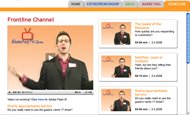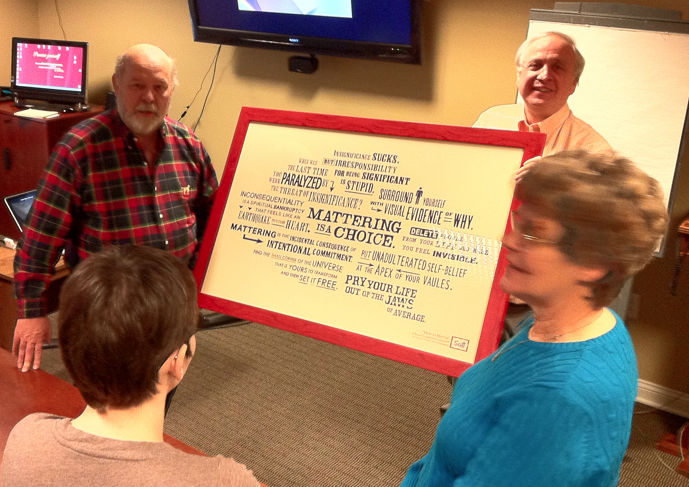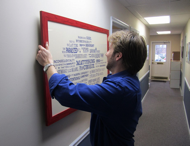 Commitment changes everything.
Commitment changes everything.
Whether you’re starting a new relationship, moving to a new city, going full time with your business or devoting your life to a charitable cause, it’s amazing how many positive results occur when you cross that threshold.
THE PROBLEM IS: Commitment is not a light switch.
It’s not something you turn on when the room goes dark.
Commitment is a daily demonstration.
Commitment is a constitutional core value.
Commitment is a posture that makes you more approachable.
Norman Vincent Peale once suggested that when you throw your heart over the fence, the rest would follow.
But he never told you how. That’s my job:1. Build commitment into your personal constitution. When you bring commitment to the forefront of your value system, throwing your heart over the fence becomes easier and easier.
My suggestion is to write a personal constitution. If you’ve never done that before, here’s an overview of this crucial life document:
Your constitution is the composition and condition of your character. It’s the established arrangement of your non-negotiables and the description of your decision-making mechanisms. It’s the collection of personal characteristics comprising your foundation. And it’s the system of fundamental values governing your behavior.
The best part is: It’s a living document. It’s amenable. And as you grow and develop personally and professionally, various elements of your constitution reserve the right to modify.
For now, your challenge is threefold: Find a place in this document for commitment, read it to yourself every morning, and share it with at least one person every day. This fixes commitment into your unconscious and makes a public declaration of your intentions. Then, when the time comes to throw your heart over the fence, you’ll have the foundation to execute. Will you name commitment as one of your core values?
2. Make the decision not to walk away. My friend Vinny has been married for over thirty years. When I asked him what the secret was, the simplicity of his answer surprised me:
“If there were problems, we dealt with it. If there were tough times, we dealt with it. But we never walked away.”
That’s the beauty of throwing your heart over the fence: Once you’re emotionally committed to a course of action, you’ll always find a way to resolve whatever practical difficulties arise.
Not because they’re easy. Not because there’s a formula. And not because you’re a genius. But because you won’t allow yourself to take no for an answer. You’ve committed, and that’s what committed people do: They deal with it. They never walk away. Even when it hurts. Even when challenges stare them down like a gunfighter.
The question is whether you’re willing to create unacceptable consequences of failing. Whether you’re willing to paint yourself into an accountable corner. And whether you’re willing to commit to not walking away. Because if you’re not, you might end up quitting when it’s hard, not when it’s right. What would your daily life feel like if you made turning back impossible?
3. Activate gravitational order. In Ed Sylvia’s metaphysical masterpiece, Proving God, he writes that motion organizes and creates order. And through motion, all things tend to their equilibrium and find their place in the universe, thus conspiring towards some unifying geometrical situation.
That’s the next secret to throwing your heart over the fence: Don’t be stopped by not knowing how. How is overrated. How is a dream destroyer. And how is the excuse you use to talk yourself out of committing with both feet.
Instead, give uncertainty a hug. Trust the process. And believe that throwing your heart over the fence doesn’t require an intimate knowledge of how the fence was built. All that matters is motion. All that matters is initiative. Even if you’re clueless, terrified and broke – it’s amazing what happens when you just start moving. The universe applauds your faith and bravery and, as Paulo Coelho says, conspires to help you follow your dream.
Look: You don’t need to take the tour and stall for another month. Stop dragging your feet. Just get a guess pass and get into the pool. And let the world say yes to you. Remember: You don’t have to get good to get going; but you do need to get going to get good. When was the last time you did something for the first time?
4. Beware of excessive restraint. Commitment changes everything. I believe this down to my bones. At the same time, there’s a paradox you’d be silly to ignore: The deeper you commit to something, the more likely you are to become so wrapped up with that something, that your desire becomes bigger than what you’re committed to.
And that’s when people start to get hurt. That’s when commitment becomes a detriment.
Take it from someone who’s been guilty of commitment to the point of detriment: Overcommitting can be dangerous. Consider these cautions:
*Don’t disrespect others because you’re too fixated on getting your own way.
*Don’t allow healthy boundary management to morph into self-righteous entitlement.
*Don’t blindly follow outdated plans that have no relationship with reality just to avoid looking inconsistent with your commitment.
Stick to your guns, but don’t shoot yourself in the foot. Stand your ground, but don’t step on people’s toes. And if you realize that you threw your heart over the wrong fence, that’s cool too.
Own it, clean up the blood and go find another fence. Are you a victim of your own conviction?
5. Boundaries are the bodyguards of commitment. I create and publish a staggering volume of material each year. And my readers, audience members and clients assume that I’m incredibly disciplined. Which I am. But the bigger picture is:
I’m not just disciplined – I’m obsessively committed to what’s really important.
I’ve developed massive intolerance for the inconsequential. And my focus filter doesn’t allow bullshit to enter without a few alarms going off. Here’s one of the questions I ask myself every day: Is this an opportunity, or an opportunity to be used?
That’s the ultimate commitment question. You might want to write it on a sticky note and keep it above your desk. Because if you don’t set healthy boundaries for yourself, people will set them for you. And then they will violate them. And out of guilt, you will overcommit to them and undercommit to yourself.
This is not fair to your dream. You need to learn how to say no. You need to practice putting a stake in the ground. And you need to be unwaveringly vigilant about the company you keep.
After all: It’s impossible to throw your heart over the fence if your feet are firmly planted in the ground of other people’s obligations. What people in your life don’t respect your commitments?
REMEMBER: The fence is there for a reason.
It’s there to test your commitment.
It’s there to show you how badly you want something.
It’s there to help you push off and move toward your dream.
Throw your heart over it.
Because even if you rip your shirt, scratch your chest and bruise your ass on the way down, commitment is the reservoir of momentum that will move you forward.
LET ME ASK YA THIS…
How committed are you?
LET ME SUGGEST THIS…
For the list called, “14 Things You Don’t Have to Do Anymore,” send an email to me, and you win the list for free!
* * * *
Scott Ginsberg
That Guy with the Nametag
Author, Speaker, Publisher, Artist, Mentor
[email protected]
Now booking for 2011-2012!
Watch The Nametag Guy in action here!


 Not everything can be comfortably quantified.
Not everything can be comfortably quantified. “I usually refuse to pay for mentoring. But after Scott’s first brain rental session, the fact that I had paid something to be working with him left my mind – as far as I was concerned, the value of that (and subsequent) exchange of wisdom and knowledge, far outweighed any payment.”
“I usually refuse to pay for mentoring. But after Scott’s first brain rental session, the fact that I had paid something to be working with him left my mind – as far as I was concerned, the value of that (and subsequent) exchange of wisdom and knowledge, far outweighed any payment.” You’ve chosen an uncertain path.
You’ve chosen an uncertain path. Authenticity is not a strategy.
Authenticity is not a strategy.
 Este Lauder once said, “Women don’t buy brands — they join them.”
Este Lauder once said, “Women don’t buy brands — they join them.” 
 My favorite scene in Good Will Hunting is the following conversation between Matt Damon and Ben Affleck:
My favorite scene in Good Will Hunting is the following conversation between Matt Damon and Ben Affleck: “I usually refuse to pay for mentoring. But after Scott’s first brain rental session, the fact that I had paid something to be working with him left my mind – as far as I was concerned, the value of that (and subsequent) exchange of wisdom and knowledge, far outweighed any payment.”
“I usually refuse to pay for mentoring. But after Scott’s first brain rental session, the fact that I had paid something to be working with him left my mind – as far as I was concerned, the value of that (and subsequent) exchange of wisdom and knowledge, far outweighed any payment.” Good brands are bought — great brands are joined.
Good brands are bought — great brands are joined.  “It’s not about the art – it’s about the person you become as you create the art.”
“It’s not about the art – it’s about the person you become as you create the art.” “It’s not about the art – it’s about the person you become as you create the art.”
“It’s not about the art – it’s about the person you become as you create the art.”